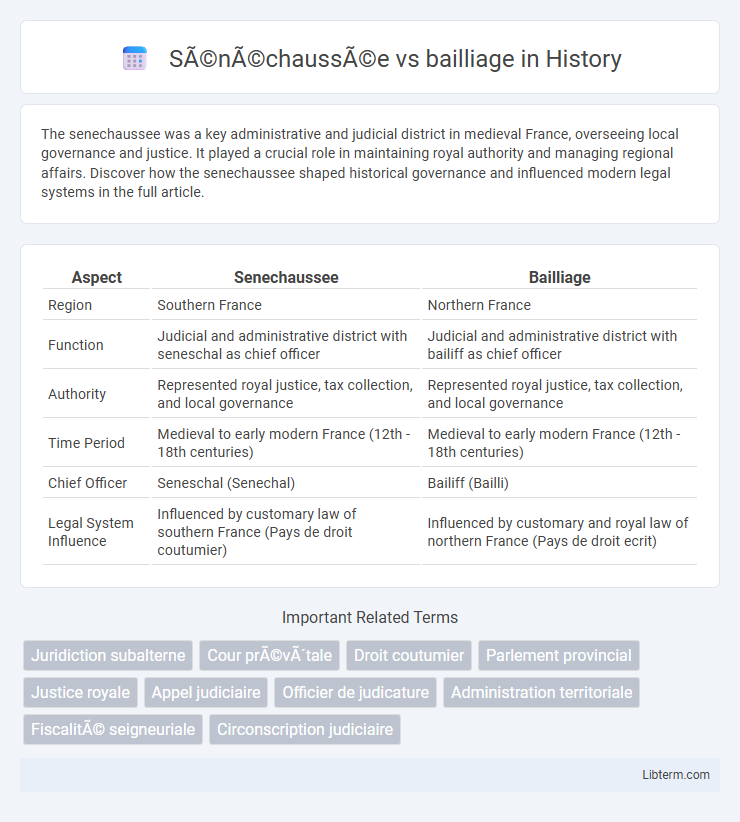The senechaussee was a key administrative and judicial district in medieval France, overseeing local governance and justice. It played a crucial role in maintaining royal authority and managing regional affairs. Discover how the senechaussee shaped historical governance and influenced modern legal systems in the full article.
Table of Comparison
| Aspect | Senechaussee | Bailliage |
|---|---|---|
| Region | Southern France | Northern France |
| Function | Judicial and administrative district with seneschal as chief officer | Judicial and administrative district with bailiff as chief officer |
| Authority | Represented royal justice, tax collection, and local governance | Represented royal justice, tax collection, and local governance |
| Time Period | Medieval to early modern France (12th - 18th centuries) | Medieval to early modern France (12th - 18th centuries) |
| Chief Officer | Seneschal (Senechal) | Bailiff (Bailli) |
| Legal System Influence | Influenced by customary law of southern France (Pays de droit coutumier) | Influenced by customary and royal law of northern France (Pays de droit ecrit) |
Introduction to Sénéchaussée and Bailliage
Senechaussee and bailliage were administrative and judicial districts in medieval France, each representing royal authority in different regions. The senechaussee operated primarily in the southern provinces, headed by a senechal who managed justice, administration, and military duties. In contrast, the bailliage, prevalent in northern France, was overseen by a bailli with similar responsibilities, reflecting the territorial and legal distinctions within the kingdom.
Historical Origins and Development
Senechaussees and bailliages originated as key administrative jurisdictions in medieval France, with senechaussees primarily established in southern regions under the control of royal seneschals, while bailliages were more common in northern territories governed by baillis. Both institutions emerged during the 12th and 13th centuries as the French monarchy sought to centralize judicial and administrative authority, replacing feudal lords' powers. Over time, these jurisdictions evolved into crucial components of the royal justice system, standardizing legal procedures and reinforcing the king's influence across the kingdom.
Geographical Distribution in France
Senechaussees were primarily established in southern France, serving as key judicial and administrative districts under the Crown, while bailliages were predominant in the northern regions, fulfilling similar roles. The geographical distribution reflected historical and cultural differences, with senechaussees found in provinces like Languedoc and Guyenne, and bailliages covering areas such as Normandy and Champagne. This regional distinction influenced the centralized royal authority's legal and administrative organization throughout the French kingdom.
Administrative Structure and Functions
Senechaussees and bailliages were key judicial and administrative districts in medieval France, with senechaussees primarily established in southern regions and bailliages in the north. Both institutions were responsible for administering royal justice, overseeing fiscal matters, and managing local governance, but senechaussees often had broader military and police functions due to regional demands. The bailli, head of a bailliage, focused on legal administration and tax collection, while the senechal of a senechaussee combined judicial authority with enforced royal presence in territories with strong feudal resistance.
Legal Jurisdiction and Authority
Senechaussee and bailliage both functioned as territorial jurisdictions in medieval France, with senechaussees primarily overseeing southern regions and bailliages covering northern areas. Senechaussees held authority over civil and criminal courts, fiscal matters, and military administration, while bailliages exercised similar jurisdiction but often included broader royal administrative duties such as tax collection and enforcement of royal justice. Both institutions represented the king's authority locally, but their legal jurisdiction and administrative scope varied according to regional customs and the evolution of royal governance.
Roles of Officials: Sénéchal vs Bailli
The Senechal, overseeing senechaussee districts, primarily managed judicial functions, local administration, and military duties, often acting as the king's representative in southern France. The Bailli, governing bailliage regions mainly in northern France, held similar responsibilities but emphasized financial administration and enforcement of royal justice. Both officials exercised significant judicial authority, but the Senechal's role was more militarized, while the Bailli's duties were more administrative and fiscal.
Impact on Local Governance
Senechaussee and bailliage structures significantly shaped medieval French local governance by delegating judicial and administrative authority to their respective officials, the senechal and the bailli. The senechaussee, primarily in southern France, allowed for regional adaptation of royal law, enhancing localized control, whereas the bailliage system in northern France centralized royal power through the bailli's oversight. These institutions influenced the balance between regional autonomy and centralized monarchy, affecting tax collection, legal enforcement, and conflict resolution at the local level.
Evolution Through the Ancien Régime
Senechaussees and bailliages served as key administrative and judicial districts in medieval and early modern France, evolving significantly during the Ancien Regime. Senechaussees primarily managed southern regions under seneschals, while bailliages operated in the north under bailiffs, both adapting to centralized royal authority. Over time, their roles converged as the monarchy expanded judicial control, streamlining governance and reinforcing royal justice throughout the kingdom.
Differences in Judicial Procedures
Senechaussee and bailliage were medieval French administrative districts with distinct judicial procedures; senechaussees operated under senechaux who presided over royal courts in the south, while bailliages, governed by baillis, served northern France. Judicial procedures in senechaussees emphasized civil law traditions influenced by Roman law, focusing on codified statutes and written records. In contrast, bailliages utilized customary law with oral trials and localized legal customs, reflecting regional variations in judicial practice.
Legacy and Modern Relevance
The Senechaussee and bailliage were key administrative jurisdictions in medieval France, with the Senechaussee more prevalent in southern regions and the bailliage in northern regions, both essential for local justice and royal authority. Their legacy persists in the modern French judicial system, influencing the territorial organization of courts and administrative offices that continue to uphold regional governance. Contemporary relevance is seen in how these historical divisions shaped the evolution of France's centralized legal framework and administrative boundaries.
Sénéchaussée Infographic

 libterm.com
libterm.com